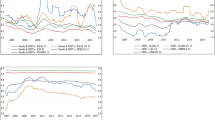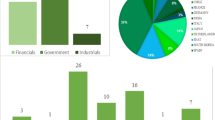Abstract
The Federal Reserve (FED) model is an empirical approach commonly used for valuation of the stock market. The model compares the earnings yield of the stock market with the nominal yield of long-term government bonds. This work investigates the validity of the FED model using Brazilian financial data. To achieve our goal, we utilized an empirical model called Vector Error Correction model (VECM), that allows to investigate the hypothesis of cointegration and causality aspects between the variables. The main results indicate the existence of favorable evidence to the long run relationship between the yields in Brazil. Also, in Brazil, there is a clear causality effect from the fixed income yields to the stock market ones.






Similar content being viewed by others
Notes
The origin of the name “FED model” is generally attributed to the following statement given by the Federal Reserve Chairman Alan Greenspan in a Monetary Policy Report for July 22nd, 1997: “\(\ldots\) the ratio of prices in the S & P 500 to consensus estimates of earnings over the coming 12 months has risen further from levels that were already unusually high. Changes in this ratio have often been inversely related to changes in long-term Treasury yields \(\ldots\)”.
The authors presumed \(EP = M\times {{\mathcal {Y}}},\) where \(M> 1\) denotes a multiplier on \({{\mathcal {Y}}}\).
As discussed in Zakamulin and Hunnes (2021), the relationship between EP and Y likely changes over time, which is consequence of changes in the economy and regulatory reforms, for example. This assumption implies some restrictions on the long-run relationship between these two variables. In this sense, as observed in Fig. 3 and discussed in Sect. 3, there is a clear outlier in \(EP_{t}\) series; besides, there are sub-periods for which the correlation between the Brazilian stock earnings and \(Y_t\) seems to be significant. These facts lead us to suspect structural breaks in the \(EP_{t}\) and \(Y_{t}\) long-run relationship. Thus, in addition to applying the widely used (Dickey and Fuller 1981) unit root tests, our stationary analysis is based on the developments of Zivot and Andrews (2002) and Lee and Strazicich (2003) (see Sect. 4.2).
Unlike the \(R^2\) criterion, the Adj-\(R^2\) can increase or decrease when the number of parameters increases. This measure is not a proportion and can even assume negative values. As a model selection criterion, the greater the Adj-\(R^2\) value the better.
References
Arranz MA, Escribano A (2000) Cointegration testing under structural breaks: a robust extended error correction model. Oxford Bull Econ Stat 62(1):23–23
Asness CS (2003) Fight the Fed model. J Portfolio Manag 30(1):11–24
Bai J (1994) Least squares estimation of a shift in linear processes. J Time Ser Anal 15(5):453–472
Bai J (1997) Estimating multiple breaks one at a time. Economet Theor 13(3):315–352
Bai J, Perron P (1998) Estimating and testing linear models with multiple structural changes. Econometrica pp 47–78
Bai J, Perron P (2003) Computation and analysis of multiple structural change models. J Appl Economet 18(1):1–22
Bekaert G, Engstrom E (2010) Inflation and the stock market: understanding the fed model. J Monet Econ 57(3):278–294
Brown RL, Durbin J, Evans JM (1975) Techniques for testing the constancy of regression relationships over time. J R Stat Soc: Ser B (Methodol) 37(2):149–163
Campbell JY (1987) Stock returns and the term structure. J Financ Econ 18(2):373–399
Campbell JY, Vuolteenaho T (2004) Inflation illusion and stock prices. Am Econ Rev 94(2):19–23
Cohen RB, Polk C, Vuolteenaho T (2005) money illusion in the stock markets: the Modigliani-Cohn hypothesis. Q J Econ 120(2):639–668
Dickey DA, Fuller WA (1979) Distribution of the estimators for autoregressive time series with a unit root. J Am Stat Assoc 74(366a):427–431
Dickey DA, Fuller WA (1981) Likelihood ratio statistics for autoregressive time series with a unit root. Econometrica pp 1057–1072
Engle RF, Granger CW (1987) Co-integration and error correction: representation, estimation, and testing. Econometrica pp 251–276
Estrada J (2006) The Fed model: a note. Financ Res Lett 3(1):14–22
Estrada J (2009) The fed model: the bad, the worse, and the ugly. Q Rev Econ Financ 49(2):214–238
Fama EF (1981) Stock returns, real activity, inflation, and money. Am Econ Rev 71(4):545–565
Fama EF, French KR (1989) Business conditions and expected returns on stocks and bonds. J Financ Econ 25(1):23–49
Graham B, Dodd DLF, Cottle S et al (1934) Security analysis, vol 452. McGraw-Hill, New York
Granger CJ (1986) Developments in the study of cointegrated economic variables. Oxford Bull Econ Stat 48(3):213–228
Granger CW (1988) Some recent development in a concept of causality. J Econom 39(1–2):199–211
Humpe A, McMillan DG (2018) Equity/bond yield correlation and the FED model: evidence of switching behaviour from the G7 markets. J Asset Manag 19(6):413–428
Ince O, Jiang L, Molodtsova T (2016) Stock return predictability and taylor rules
Jansen DW, Wang Z (2006) Evaluating the “fed model’’ of stock price valuation: an out-of-sample forecasting perspective. Econom Anal Financ Econ Time Ser 20:179–204
Johansen S (1991) Estimation and hypothesis testing of cointegration vectors in gaussian vector autoregressive models. Econom J Econom Soc pp 1551–1580
Johansen S (1995) Likelihood-based inference in cointegrated vector autoregressive models. Oxford University Press, Oxford
Keim DB, Stambaugh RF (1986) Predicting returns in the stock and bond markets. J Financ Econ 17(2):357–390
Koivu M, Pennanen T, Ziemba WT (2005) Cointegration analysis of the FED model. Financ Res Lett 2(4):248–259
Krämer W, Ploberger W, Alt R (1988) Testing for structural change in dynamic models. Econom J Econom Soc pp 1355–1369
Lander J, Orphanides A, Douvogiannis M et al (1997) Earnings forecasts and the predictability of stock returns: evidence from trading the S & P. Citeseer
Lee J, Strazicich MC (2003) Minimum lagrange multiplier unit root test with two structural breaks. Rev Econ Stat 85(4):1082–1089
Leybourne SJ, Newbold P (2000) Behaviour of the standard and symmetric Dickey–Fuller-type tests when there is a break under the null hypothesis. Economet J 3(1):1–15
Leybourne SJ, Mills TC, Newbold P (1998) Spurious rejections by Dickey–Fuller tests in the presence of a break under the null. J Econom 87(1):191–203
de Lima-Amorim DP, de Camargos MA (2020) Relationships between price-earnings ratios and returns of treasury bonds. Br Rev Financ 18(3):27–51
Maio P (2013) The FED model and the predictability of stock returns. Rev Financ 17(4):1489–1533
McMillan DG (2018) Forecast and market timing power of the model and the role of inflation. In: Predicting Stock Returns, Springer, pp 103–129
Modigliani F, Cohn RA (1979) Inflation, rational valuation and the market. Financ Anal J 35(2):24–44
Perron P (1989) The great crash, the oil price shock, and the unit root hypothesis. Econom J Econom Soc pp 1361–1401
Ploberger W, Krämer W (1992) The CUSUM test with OLS residuals. Econom J Econom Soc pp 271–285
Schmidt P, Phillips PC et al (1992) LM tests for a unit root in the presence of deterministic trends. Oxford Bull Econ Stat 54(3):257–287
Sharpe WF (1964) Capital asset prices: a theory of market equilibrium under conditions of risk. J Financ 19(3):425–442
Carrion-i Silvestre JL, Kim D, Perron P (2009) GLS-based unit root tests with multiple structural breaks under both the null and the alternative hypotheses. Econom Theor 25(6):1754–1792
Zakamulin V, Hunnes JA (2021) Stock earnings and bond yields in the us 1871–2017: the story of a changing relationship. Q Rev Econ Financ 79:182–197
Zivot E, Andrews DWK (2002) Further evidence on the great crash, the oil-price shock, and the unit-root hypothesis. J Bus Econ Stat 20(1):25–44
Acknowledgements
The authors thank an anonymous referees for comments and suggestions that led to a much improved manuscript. They also gratefully acknowledge partial financial support from CNPq, Brazil.
Author information
Authors and Affiliations
Corresponding author
Ethics declarations
Conflict of interest
The authors declare that they have no known competing financial interests or personal relationships that could have appeared to influence the work reported in this paper.
Ethical Approval
No animal or human studies were carried out by the authors in this work; hence ethical permission is not required.
Rights and permissions
About this article
Cite this article
Bernardino, W., Amaral, J.B., Paes, N.L. et al. A statistical investigation of a stock valuation model. SN Bus Econ 2, 106 (2022). https://doi.org/10.1007/s43546-022-00270-x
Received:
Accepted:
Published:
DOI: https://doi.org/10.1007/s43546-022-00270-x
Keywords
- Brazilian economy
- Cointegration analysis
- FED model
- timing market model
- Stock market
- Fixed income
- Vector error correction model




